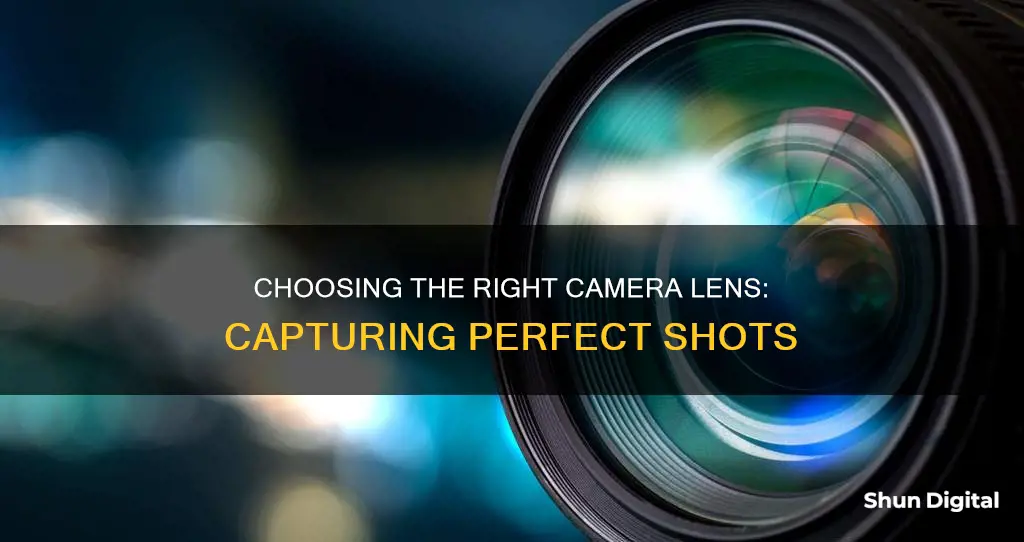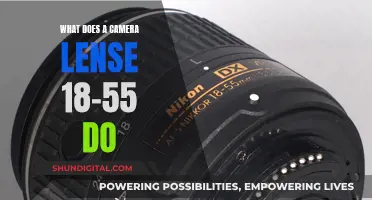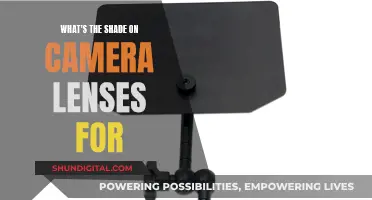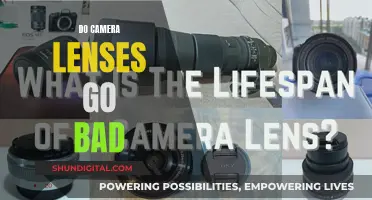
Choosing the right camera lens can be daunting, but it's an essential part of photography. The lens you choose will depend on the type of images you want to capture and your personal preferences.
There are three key elements to consider when choosing a lens: focal length, aperture, and whether to go for a zoom or prime lens. Focal length refers to the lens's angle of view and how zoomed-in it is. For faraway subjects, a lens with a long focal length (above 100mm) is ideal, while for closer subjects, a lens between 24-70mm is more suitable. Aperture, measured in f-stops, refers to how wide the lens opens. Wide-aperture lenses (f/2.8 or wider) are better for low-light settings and can create a bokeh effect, while narrow apertures (f/11 or narrower) are best for wide-angle shots. Zoom lenses offer more versatility as you can adjust the focal length, whereas prime lenses provide sharper images and typically have wider apertures.
Other factors to consider include the type of camera you have, your budget, and whether you want to invest in additional gear like lens filters or a tripod. It's also worth thinking about renting lenses to try them out before committing to a purchase.
With so many options available, it's important to do your research and choose the lens that best suits your photography needs and style.
| Characteristics | Values |
|---|---|
| Focal length | 18mm or less for cropped-sensor cameras; 28mm or less for full-frame cameras |
| Aperture | f/2.8 or wider for low light; f/11 and narrower for wide-angle shots |
| Zoom vs. prime | Zoom lenses are more versatile; Prime lenses take sharper pictures and typically have wider apertures |
What You'll Learn

What camera lens for portraits?
When it comes to choosing a camera lens for portrait photography, there are a few key factors to consider. Firstly, it's important to understand the different types of lenses available. The two main types are zoom lenses and prime lenses. Zoom lenses offer versatility as you can adjust the focal length to zoom in and out, whereas prime lenses have a fixed focal length and are typically sharper and have wider apertures.
For portrait photography, a good starting point is a 50mm lens. This focal length is versatile and can be used for full-length and waist-length portraits, both on location and in the studio. It allows you to stand close to your subject while capturing more of their body and background. However, 50mm lenses may not be ideal for intimate headshots as they can cause distortion when the photographer is too close to the subject. An alternative option is an 85mm lens, which is a very popular choice for portraits. This lens allows for a reasonable working distance from the subject while providing a narrower field of view for better focus. It is versatile and can be used for full-length photos, waist-level crops, and intimate headshots.
If you're looking for even more flexibility, consider a 70-200mm lens. This zoom range is great for capturing portraits at various distances without having to move around too much. However, keep in mind that longer focal lengths can make it challenging to work in tight spaces, especially in a studio setting.
Another factor to consider when choosing a lens for portraits is the aperture. A wider aperture, such as f/2.8 or wider, can create a beautiful bokeh effect and is ideal for low-light conditions. On the other hand, narrower apertures, such as f/11 and narrower, are better suited for wide-angle shots.
Additionally, the quality of the lens is important. Higher-quality lenses tend to produce sharper and more colourful images, even in low-light conditions. They often feature image stabilisation, fast and quiet autofocus, and durable, weather-sealed construction.
In summary, when choosing a camera lens for portraits, consider your shooting style, the desired focal length, aperture range, and image quality. Experiment with different lenses and find the ones that best suit your creative needs and budget.
The Ultimate Guide to Cleaning Coated Camera Lenses
You may want to see also

What camera lens for landscapes?
When it comes to landscape photography, the lens you choose can make a huge difference to the final image. Wide-angle lenses are the most popular choice for landscapes, as they offer a broad field of view, enabling photographers to capture large expanses of scenery within a single frame. They also provide a greater depth of field, allowing for both the foreground and background to be sharply focused.
However, there are many other lenses that can be used for landscape photography, each offering a different perspective and style. Telephoto lenses, for example, are perfect for isolating specific elements within a landscape, such as a single mountain peak or an interesting tree. Standard lenses, which have an angle of view similar to that of the human eye, are another versatile option, capable of capturing landscapes that appear "natural" to viewers.
- Canon EF 16-35mm f/4L IS USM: This lens is a great choice for Canon full-frame DSLR or mirrorless users. It offers a nice range of focal lengths, very sharp image quality, and an ultrasonic focus system. It's also reasonably priced, making it a good option for enthusiasts.
- Nikon Z 14-30mm f/4 S: This lens is ideal for Nikon full-frame mirrorless cameras. It's lightweight, compact, and offers a wide perspective, making it perfect for travel landscape photographers. It also supports direct filter attachment, expanding the creative possibilities.
- Fujifilm XF 10-24mm f/4 R OIS: This lens is a great choice for Fujifilm X-mount users. It offers enhanced optical image stabilization, a minimum focusing distance of 9 inches, and great image sharpness across the focal range. While it's on the expensive side, it's worth the investment for serious landscape shooters.
- Sony FE 12-24mm f/2.8 GM: If you're an experienced photographer with a high budget, this Sony lens is the ultimate choice. It offers sharp optics, incredible build quality, and a surprisingly lightweight body. The f/2.8 maximum aperture is perfect for astrophotography and adding artistic background blur.
- Nikon AF-S NIKKOR 16-35mm f/4G ED VR: This lens is a fantastic option for Nikon full-frame DSLR users. It provides a beautiful wide-angle perspective, great image stabilization, and a relatively lightweight design. It's also inexpensive, making it a good choice for enthusiasts.
- Sony E 10-18mm f/4 OSS: For Sony APS-C mirrorless users, this lens is a great budget-friendly option. It's small, lightweight, and offers excellent optical performance, with sharp image quality even at the widest focal lengths. The Optical SteadyShot feature keeps handheld shots blur-free.
- Canon EF 24-70mm f/2.8L II USM: This lens is pricier, but offers a versatile focal range, allowing you to capture both wide-angle and intimate landscape shots. The f/2.8 maximum aperture is ideal for astrophotography and experimenting with shallow depth of field.
When choosing a lens for landscape photography, consider your camera model and lens compatibility. Other factors to keep in mind include focal length, minimum focusing distance, aperture, image stabilization, weight, and dimensions. Ultimately, the best lens for you will depend on your personal style, the specific scenarios you're shooting in, and your creative vision.
Lens Compatibility: Matching Lenses to Your Camera
You may want to see also

What camera lens for wildlife?
When it comes to wildlife photography, the lens you choose is incredibly important. The "best" lens will depend on your specific needs, preferences, and style of photography.
- Focal length: A longer focal length will allow you to get closer to your subject without disturbing them. For wildlife photography, a telephoto lens is typically recommended, with a focal length of at least 300mm.
- Aperture: A wider aperture (e.g., f/2.8 or f/4) will let in more light, which is beneficial in low-light conditions and can help create a shallow depth of field to blur the background. However, wider apertures also tend to be more expensive and heavier.
- Image stabilization: This feature helps reduce camera shake when shooting handheld, which is common in wildlife photography. Look for lenses with optical image stabilization or vibration reduction technology.
- Weight: Lenses can get heavy, especially the longer and faster ones. Consider the weight of the lens, especially if you plan to do a lot of hiking or travelling with your gear.
- Budget: Wildlife lenses can range from a few hundred to several thousand dollars. Determine your budget and look for lenses that offer the best value within that range.
- Zoom lenses: Zoom lenses offer flexibility and are generally more affordable. The Canon EF 100-400mm f/4.5-5.6L IS II USM and the Nikon AF-S Nikkor 200-500mm f/5.6E ED VR are popular choices, offering good image quality and versatility.
- Prime lenses: Prime lenses tend to be sharper and faster than zoom lenses but are usually more expensive. The Nikon NIKKOR Z 400mm f/4.5 VR S and the Canon EF 600mm f/4L IS III USM are excellent options for those who can afford them.
- Third-party lenses: If you're on a tighter budget, consider third-party options like the Sigma 150-600mm f/5-6.3 DG OS HSM Contemporary or the Tamron SP 150-600mm G2 F/5-6.3 Di VC. These lenses offer good optical performance at a lower price.
- Camera-specific lenses: Different camera brands have their own lens options that are designed to work optimally with their cameras. For example, Sony offers the FE 200-600mm f/5.6-6.3 G OSS, and Nikon has the NIKKOR Z 800mm f/6.3 VR S.
Remember that the "best" lens for wildlife photography depends on your specific needs and budget. Consider the factors mentioned above and choose a lens that suits your style of photography.
How to Eclipse-Proof Your Camera Lens
You may want to see also

What camera lens for street photography?
Street photography is all about capturing fleeting moments, so you'll need a camera lens that can keep up. The best lenses for street photography are generally considered to be prime lenses, which have a fixed focal length. They tend to be smaller, lighter, optically superior, and allow for a wider aperture than zoom lenses.
When it comes to the focal length, opinions vary. Some street photographers prefer a 50mm lens, which is often referred to as the "nifty fifty". It's a versatile lens that can be used for a variety of applications and is ideal for those who are nervous about street photography as you don't have to get too close to your subjects.
However, many street photographers opt for a 35mm lens, which is wide enough to capture multiple subjects in the frame, yet also close enough to shoot portraits. It's also a good choice for zone focusing and has a larger depth of field, which can cover up focusing mistakes.
If you're using a compact or point-and-shoot camera, or shooting with the LCD screen, a 28mm lens is recommended as it will give you a tighter frame.
Other focal lengths to consider are 24mm, which is a good choice for busy areas, and 40mm, which can provide a more naturalistic view.
- Nikon Z: Nikon NIKKOR Z 35mm f/1.8 S
- Sony FE: Sony FE 24mm f/1.4 GM or Sony FE 35mm f/1.8
- Canon RF: Canon RF 50mm F1.2L USM or Canon RF 35mm f/1.8 IS Macro STM
- Fujifilm X: Fujifilm XF 27mm f/2.8 R WR or Voigtlander Nokton 50mm f1.5 (adapted for Sony A7 cameras)
- Micro Four Thirds: Panasonic Lumix G 25mm f/1.7 Asph or Olympus M.Zuiko Digital ED 25mm F1.2 PRO
- L-mount: Sigma 35mm f1.4 DG DN Art or Sigma 35mm f/2 DG DN Contemporary
Handcrafted Zeiss Lenses: Precision and Artistry in Optics
You may want to see also

What camera lens for product photography?
When it comes to product photography, there are a few things to consider when choosing the right lens.
Focal Length
The focal length of a lens is how zoomed-in it is. If you are shooting small products, a lens with a focal length of 24-70mm will be a good option. For larger products, a lens with a focal length of 100mm or more will be more suitable.
Aperture
The aperture of a lens refers to how wide it opens. Wide-aperture lenses (f/2.8 or wider) are better for low-light conditions and can create a bokeh effect, while narrow apertures (f/11 or narrower) are best for wide-angle shots.
Zoom vs Prime
Zoom lenses are more versatile as they allow you to adjust the focal length. This means you can zoom in and out to capture your subject without having to move. Prime lenses, on the other hand, cannot zoom, but they generally produce sharper images and have wider apertures.
Lens Recommendations
- Canon EF 100mm f/2.8L IS USM Macro: This lens offers an excellent focal length, great image quality, and superb handling, making it a top choice for product photography.
- Canon EF 50mm f/1.8 STM: This is an inexpensive lens that delivers high-quality images and is ideal for capturing everything with precision.
- Nikon AF-S 105mm f/2.8G VR Micro: This lens provides stunning image quality, 1:1 focusing, and excellent handling, making it a great option for Nikon users.
- Sony 90mm f/2.8 Macro G: This lens offers pro-level image quality, close-focusing capabilities, and a versatile focal length, making it a top choice for Sony shooters.
- Sigma 105mm f/2.8 EX DG OS HSM Macro: This is a low-priced macro lens that delivers sharp images and is perfect for small products and details.
Differentiating Camera Lenses: A Guide to Spotting the Differences
You may want to see also
Frequently asked questions
The Sigma 35mm lens is a great all-round lens for everyday use. It's good for indoor and outdoor photography, and can be used for family and newborn portrait sessions.
The classic choice is a 50mm standard lens, which is affordable, lightweight, bright, optically excellent, and will teach you about your needs for your ultimate lens kit. A more versatile option is a wide-to-telephoto zoom lens, such as a 24-105mm or 28-200mm.
For portraits, a lens with a longer focal length is best, as this flatters the subject's facial features by softening sharp lines or wrinkles and creating a soft background blur. An 85mm focal length is generally considered the sweet spot, but lenses ranging from 50mm to 135mm are also popular.







